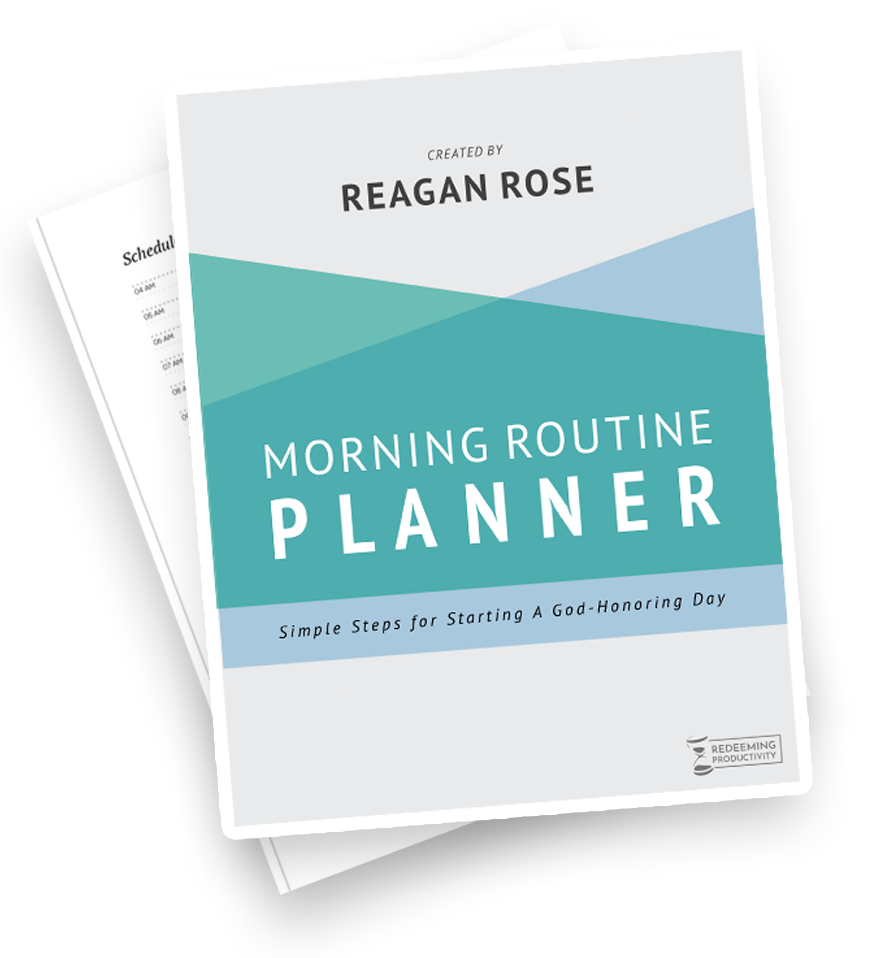This week’s post on the Bullet Journal system is written by Emily Maxson.
Emily graduated from Hillsdale College with a B.A. in History and an addiction to research. When not occupied with housewifery, she maintains interests in theology, education, and vintage jazz.
If you, like Emily, are a Christian with a penchant for productivity and are interested in guest writing for Redeeming Productivity, please reach out.
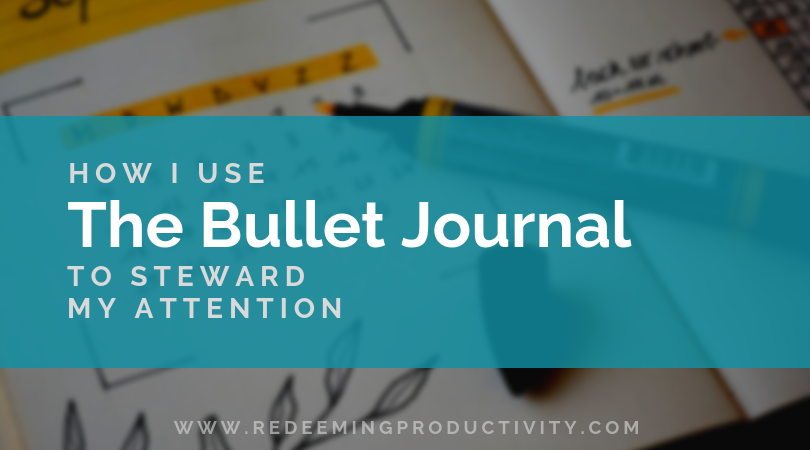
By Emily Maxson
I faced my first real crisis of productivity in my final semester of college. For years, procrastination—or, as I thought of it, patiently awaiting inspiration—had always worked out in the end. But now, severe burnout joined forces with a vitamin deficiency, poor time and energy management, and my least favorite class, to bring my pretense of a workflow to a grinding halt.
I had been taught to glorify God through faithful and diligent work, and I had even written a research paper on the topic. In high school I wrote a term paper about the image of God in man as manifest in the dominion impulse. But despite all of this I still clung to an absurd pride in my habit of poor planning. I trusted in myself that even without thoughtful preparation I could make it through on improvisation—I was just that good.
Until I wasn’t.
I got to this point where I would sit down at my computer to write a paper, compose a single sentence, edit it into oblivion, and sit staring once again at a blank document. I started to lose track of due dates, and began missing deadlines on projects. That vague feeling of always being slightly behind grew into a certainty. I had lost control.
This wasn’t a crisis of productivity alone. It was also a crisis of character. I was failing to steward faithfully the things which God had entrusted to me. It was
Enter the Bullet Journal.
In this post, I outline the basic system which helped me get a handle on life and describe some of the additional content which I’ve found most useful.
The Structural Components of The Bullet Journal
One of the Bullet Journal’s strongest virtues is its flexibility. You design and adjust the format to suit how you think and how you work. And you don’t need to purchase any kind of special products. You can use any notebook you have on hand. Whatever your goals, there’s a way to leverage the Bullet Journal to help you dedicate attention to them.
Four basic components provide the skeleton for the system’s functionality: the Index, the Future Log, the Monthly Log, and the Daily Log. I’ll describe them here, but I’ll also link you to a couple of helpful and succinct videos that show the BuJo in action: creator, Ryder Carroll’s official introductory video from BulletJournal.com, and my favorite practical demo from a pastor who uses the system.
The Index
The Bullet Journal index goes in the first blank two-page spread of your notebook. It functions as a table of contents which you create as you fill your BuJo. As you use each page in your notebook, number it (or use a notebook with pre-printed page numbers) and put a title at the top. Then enter the title and page number in your index. Later, when you’re looking for the notes from that one meeting or that one train of thought, you’ll be able to look at your index and know exactly where to find them.

Simple, right? But for me, this was life-changing. The mere act of titling each page gave it a distinct identity in
The Future Log
The Bullet Journal Future Log comes next after the index. To create yours, use a ruler to divide the next two-page spread into thirds horizontally, creating six compartments, and label them for the next six months.
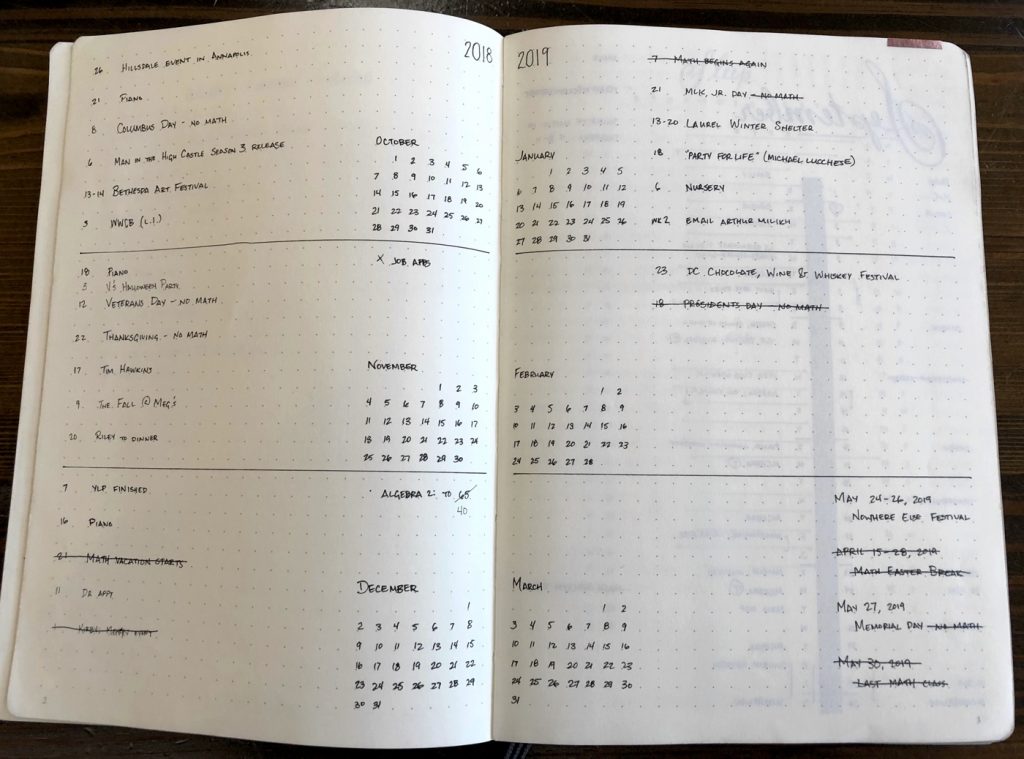
This is where you make note of long-term goals like “Finish thesis first draft,” tasks that will become relevant in a certain month (e.g. “Renew lease”), or scheduled events (e.g. “Geoff & Tricia Wedding”).
The Monthly Log
At the beginning of each month, dedicate the next available double spread to the Monthly Log. The month and year go at the top (that’s your title, which you’ll enter into the Index). The left page will function like a calendar, while the right page will contain tasks and goals, as well as details for the items on the calendar.
First, put the days of the month in a column down the left side of the left page. Next to each number, put the first letter of the day of the week. Look back at your Future Log, and copy any item attached to a specific day into its line on the left page of your Monthly Log.
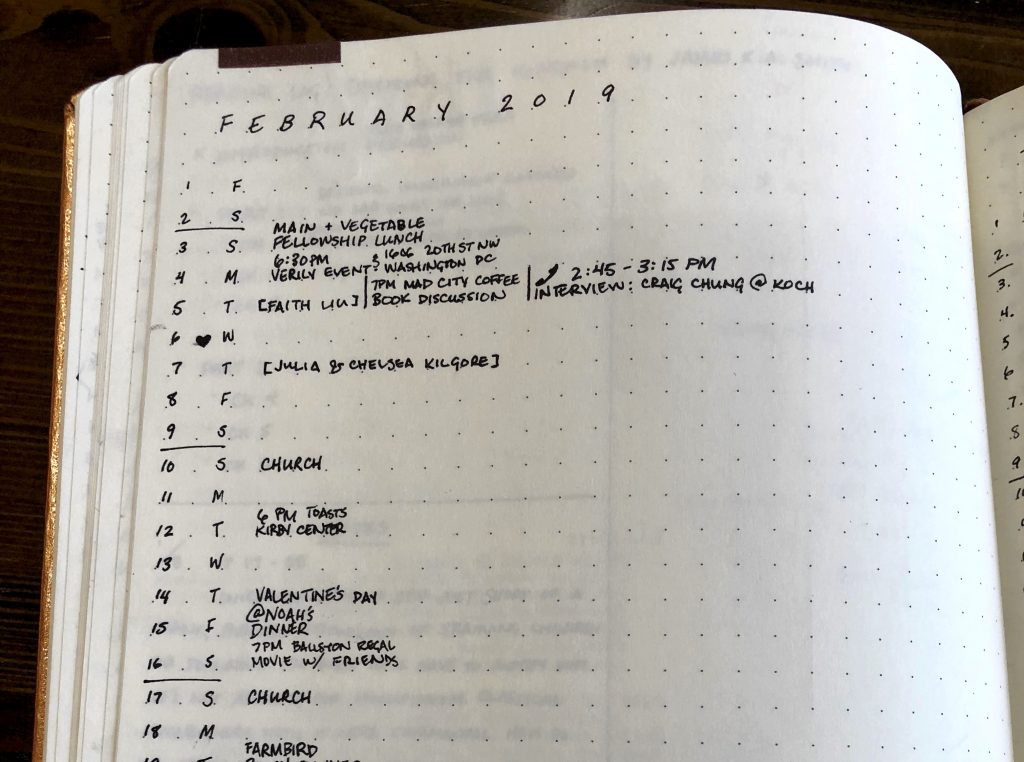
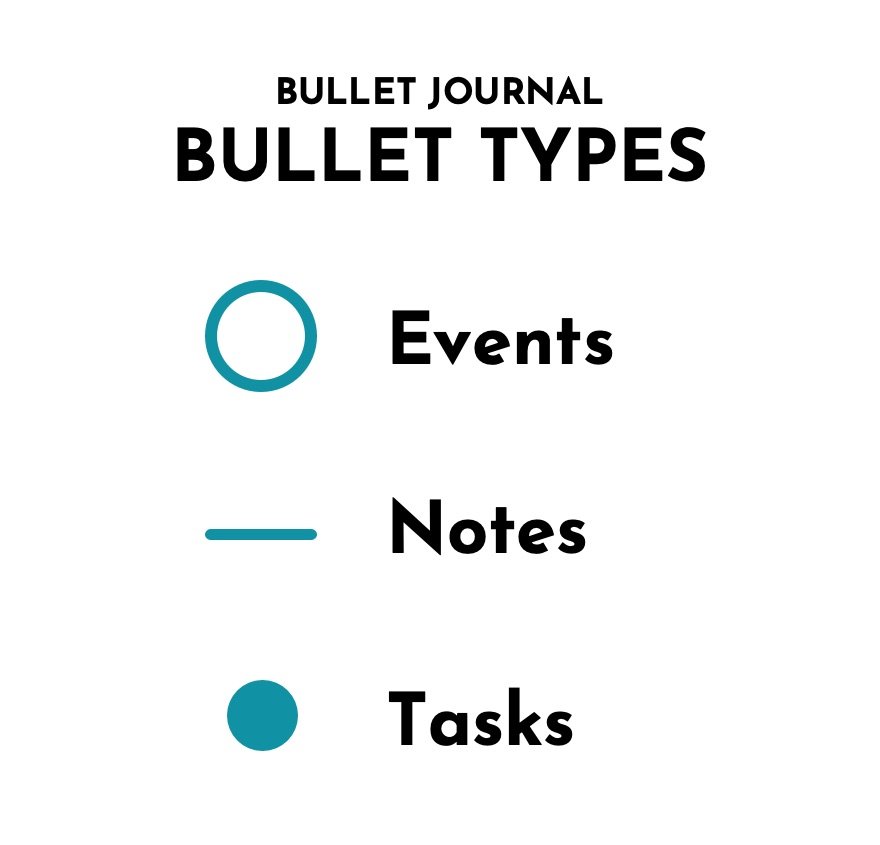
Throughout the month, you can continue to use this page for scheduling in advance as well as for recording a day’s happenings as they occur. Because most of us have more than one thing happening on any given day, it’s best to use a short key-phrase or descriptor, like “Staff Meeting” or “Started weight training,” rather than including details like the time and location, so that you have room for multiple items on each day.
Details can go on the right page, along with tasks and goals for that month—both brand new ones and the ones informed by the goals in your Future Log. These are entered as bullet points, which is where the Bullet Journal gets its name. Each type of item has a different bullet type: events get a circle, notes get a dash, and tasks get a single dot. More on the task dot in a moment.
The Daily Log
The Daily Log is where the rubber meets the road. You don’t need to title this page or enter it into your Index, because its purpose is to catch all the random things that come up as you’re going about your day. The key word here is capture. It will all be sorted later.
To create your daily log make a note of the day’s date, and beneath that, enter items as needed using the different types of bullet points described above. Complete sentences aren’t necessary—just write enough that you’ll understand what you meant later. Ryder calls this process “Rapid Logging.”
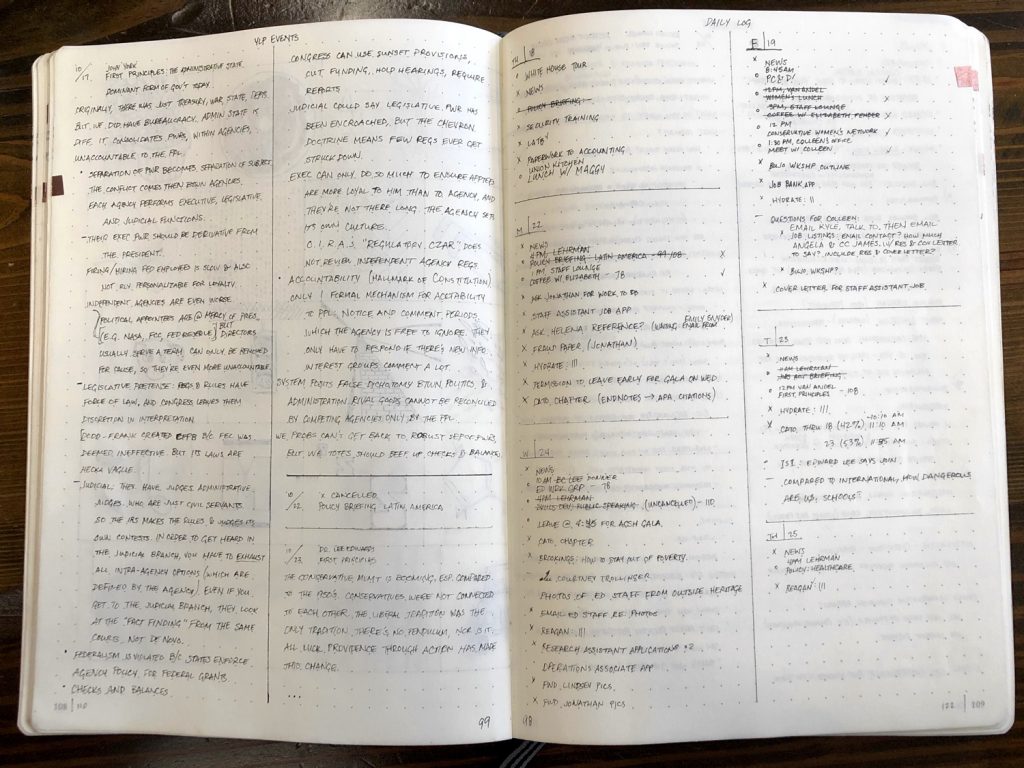
Because most of my work these days is in my home, I tend to leave my journal on my kitchen table, open to this page. That makes it easy for me to jot down things as I remember them, and to quickly see what I still need to do. When I worked in an office, I would have separate Daily Logs for work and home, but not everyone finds that division helpful or necessary.

Later, at the end of the day or during a break to refocus, look back through the items you’ve entered in your Daily Log. Copy any new events into their places in the Monthly Log or Future Log, and then consider each of the tasks. If you’ve completed it, turn the dot bullet into an X. If the task is no longer relevant to your life, strike it out. If it isn’t relevant now but will be later, copy it into the Monthly Log or Future Log as appropriate, and turn the dot bullet into a right arrow to signify that it’s been “Migrated” to its proper place.
If at the end of a day you haven’t done a task but still need to, you can either copy it into the next day’s log or just leave it, depending on your preference. If I’m not starting the next day’s log on a new page, I usually leave it unless I feel that I need to prioritize that task the next day. I’m still looking at the same page, so I’ll still see that I need to do it. If, on the other hand, I am starting a new page, I migrate the task to the next log so I don’t forget it.
Intentionality: The Key to The Bullet Journal Method
The key to using these basic components effectively is intentionality. Writing down each item by hand (sometimes multiple times) means that you are committing time and effort to include these things in your life. When you’re reflecting on your Daily Log in the evening and see something that doesn’t end up mattering all that much, crossing it out means that you’ve made the conscious decision to give attention instead to things that are more valuable.
At the same time, all of this is much more complicated and time-consuming to explain
Your Personal Content: Bullet Journaling Ideas
But the Bullet Journal isn’t just made up of logs. It’s also a place for pretty much anything else you would write down for yourself: sermon notes, class notes, grocery lists, books you want to read, business plans, gift ideas… whatever you need. Having all of your lists and notes in one place, and always with you in your handy notebook, saves an enormous amount of time and effort.
Bullet Journal Collections
The pages you dedicate to these topics are called Collections. Collections can span any number of pages, and the pages need not be consecutive. As long as you enter each additional page number in the Collection’s Index entry, you’ll be able to find them. Everyone’s collections are different, and you can experiment with different formats to optimize their usefulness to you.
For example, if there are a lot of books I want to read (which there are), I create a Collection for them by titling my next available empty page “Books to Read,” and entering the title and page number back in my Index. From then on, I can migrate book recommendations from my Daily Log to this list, or just put them there directly.
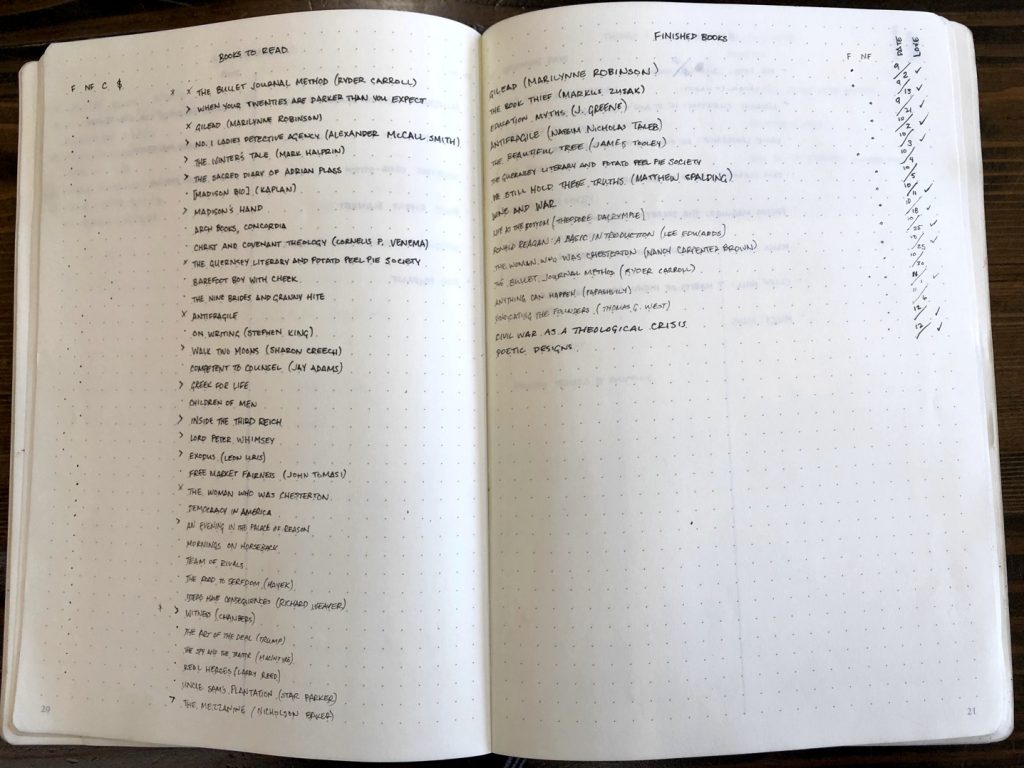
My first book list was just that—a list, with a task bullet next to each title. My current book list, six Bullet Journals later, has a few more tools incorporated into it. On the left side of the page I have two columns labeled for fiction and nonfiction, so that I can mark the appropriate column for each new entry. This reminds me that I want to read more fiction, and lets me see at a glance which books I should choose from to advance that goal.
On the opposite page of the spread, I also keep track of books that I’ve finished reading, with columns to note when I finished them and whether or not I loved them. This is useful to me because I often forget the title or author of a book that I’ve read recently but want to recommend, and because it provides a record of how I’ve invested my time. I also find it encouraging to see a list of accomplishments, as I’m often tempted to despondence if I don’t see some concrete result of some hours’ labor.
The Weekly Log
There are many more useful tools and techniques, but I’ll close with my favorite: the Weekly Log. Although it’s not part of the original system, a substantial portion of the Bullet Journal community uses a two-page spread to provide context for a week’s worth of Daily Logs. I love that, because it testifies to the theological and practical truth that God designed humanity to operate with a weekly rhythm. Turning to a fresh new page each Sunday reinforces that rhythm, and reminds me to treasure the holy day of rest and worship that God has been so gracious to provide.
For my Weekly Logs, I typically use a ruler to divide a two page spread into fourths with vertical lines. In the far left quarter, I set up a chart for all the basics that I aspire to do on either a daily or weekly basis–things like taking my vitamins, Bible reading, laundry, music practice, etc. The other three quarters of the spread are left blank for Daily Logs, with the exception of a little space set aside to remind me what events are happening that week. If I end up needing more room (which is rare), I use the next available blank page.
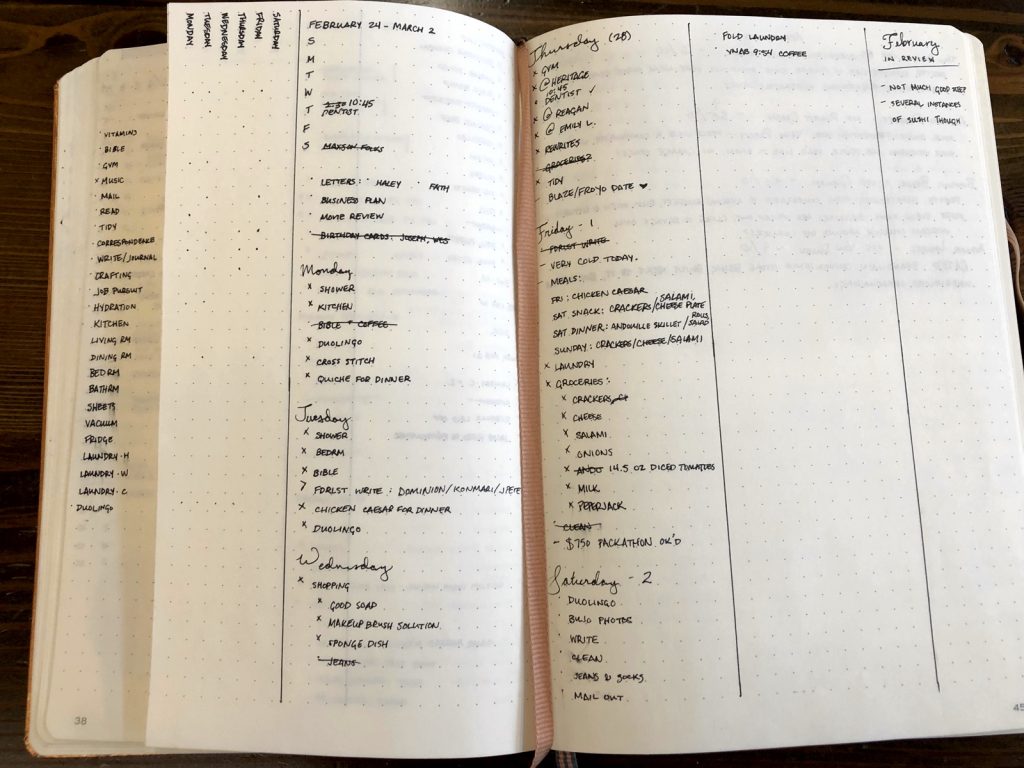
More often than I’d like to say, I struggle with laziness and lack of
Conclusion
All of the formatting I’ve described in this article is customizable. The important thing is that it is helpful to you. Sometimes people spend so much time customizing their notebooks and making artistic spreads that the journal ends up being a project in itself, rather than a tool for managing the other aspects of their lives. Art (and good design more generally) can promote a peace of mind that contributes to productivity, but the main thing is to find the design that is the most conducive to good stewardship for you.
Since starting my first Bullet Journal, I’ve graduated college, moved across the country twice, married my husband, and had five different jobs (six if you count housewifery). Throughout each stage, the notebook I carry with me everywhere has been my most valuable tool for growing in faithfulness in my various callings. If you’re looking for one thing to make your life more organized, I highly recommend giving the Bullet Journal a try.
Recommended Bullet Journal Resources
While the Bullet Journal is notebook agnostic, a good notebook and pen will serve you well in the process of creating yours. Opening up a new notebook and getting to work with a new pen might just be the boost of motivation you need to dive into a new productivity system. Here are a few recommendations to get you started with the Bullet Journal method.
Dotted Notebooks for Bullet Journaling
You’ll find that dotted (as opposed to lined, or even blank) notebooks are more conducive to the BuJo method.
- I use the Leuchtturm1917 Hardcover Medium A5 Dotted Notebook
- I keep coming back to it for the multiple bookmarks and the pre-printed page numbers.
- Alternatively, there’s the popular Rhodiarama Dot Notebook by Rhodia
- Made with very high-quality paper (takes fountain pen ink!)
- Available in many colors
- For a more affordable yet sturdy option try the Minimalism Art Classic Dotted Notebook.
Pens for Bullet Journaling
- Recommended Fountain Pen: Lamy Safari Fountain Pen
- If you’ve never tried a fountain pen, now might be a good time to start.
- Fountain pens, like the Bullet Journal method, lend themselves to deliberate thought.
- A fountain pen can also bring an extra level of pleasure to the act of writing.
- The Lamy Safari fountain pen is a great and stylish fountain pen if you’ve never used one before. The fine nib creates a
beautiful thin, crisp line perfect for maximizing space on the pages of your BuJo.
- Recommended Roller Ball Pen: Pilot G2 Ultra Fine Point
- For a roller ball pen, you really cannot beat the Pilot G2. The ultra-fine point version is excellent for writing small and avoiding page bleed.

